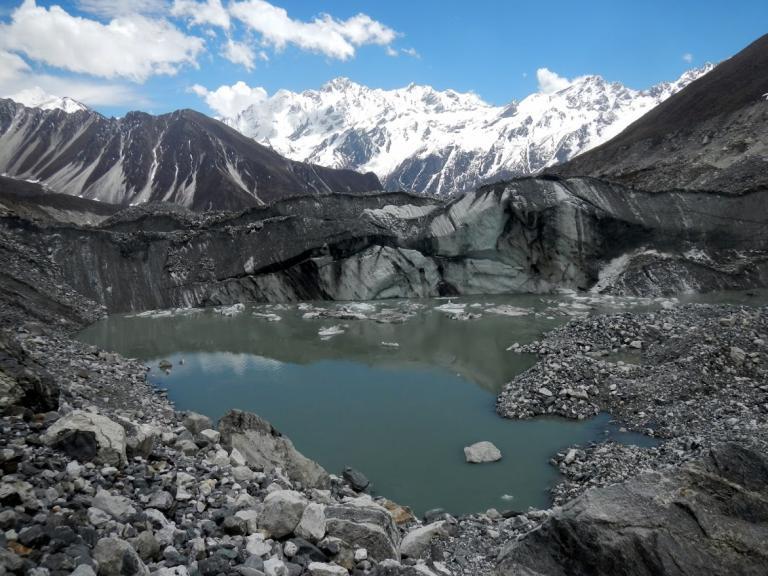
Lead supervisor: Ian Willis, Scott Polar Research Institute
Co-supervisor: Becky Dell, Scott Polar Research Institute; Francesca Pellicciotti, Institute of Science and Technology Austria (ISTA); Evan Miles, Swiss Federal Research Institute WSL
Brief summary:
Developing classification and machine learning algorithms to map glacier surface ponds and their seasonal and annual changes from satellite imagery and in-situ data sets across High Mountain Asia.
Importance of the area of research concerned:
High Mountain Asia (HMA), often called the 'Third Pole' or the ‘Roof of the World’, contains ~15,000 km3 of glacier ice, the biggest reservoir outside the polar regions. The region's glaciers regulate discharges in rivers used for irrigation, sanitation, and hydropower by millions of people. Many of the large glaciers have a thick debris mantle over their lower elevations. Local-scale studies show that thick debris insulates the underlying ice, reducing surface melt rates. But large-scale studies across HMA suggest that surface lowering rates of debris-covered and 'clean' glaciers are comparable. Surface ponds and lakes and their associated ice cliffs may account for this discrepancy, acting as 'hot spots'; absorbing energy and directing it to the underlying ice surface, or putting it into the glacier when the ponds drain, thereby enhancing surface and subsurface melting. Despite recent progress, there are still relatively few studies that have monitored surface pond evolution throughout entire annual cycles and used the measurements to infer hydrological processes or examine the implications for glacier mass balance across HMA.
Project summary :
Building on a recent SPRI master’s dissertation, the project will use satellite imagery to map changing pond areas across debris-covered glaciers in High Mountain Asia. Within Google Earth Engine, it will adapt existing classification, machine learning, and lake-drainage-detection algorithms developed at SPRI and use the datasets to examine how ponds fill, drain and freeze over seasonally, whether these cycles vary between regions, or from year-to-year. Existing field data will be used to validate the approach. The project may then: examine the topographic and climatological controls on pond cycle variability; estimate the implications for energy inputs to the glacier surface and subsurface; or examine glaciers’ plumbing, e.g., by identifying simultaneous pond draining and down glacier filling events, or the transfer of water with distinct reflectance characteristics between ponds.
What will the student do?:
The student will familiarise themselves with classification and machine learning algorithms developed at SPRI to map slush and lakes across Antarctic ice shelves, and with an algorithm used to detect lake drainages on the Greenland Ice Sheet. Existing (or new) schemes will be used to map pond areas across the glaciers of HMA using optical (Landsat and Sentinel-2) and possibly SAR (Sentinel-1) imagery, and their changes through time at an, e.g., monthly resolution. This new data set will be used to examine how ponds fill, empty, or freeze over seasonally, whether such cycles vary between regions, and whether they show any interannual variability. Existing in-situ data will be used for validation. The project could then be used to: i) examine the topographic and climatological controls on the pond cycle variability using existing digital elevation and climate reanalysis or model data; ii) use energy balance theory to calculate energy transfers between ponds and surface and subsurface, and the implications for the mass budget of the glaciers; iii) investigate the detailed plumbing of specific glaciers, by identifying water transfer events between ponds.
References - references should provide further reading about the project:
Miles, E.S., Willis, I., Buri, P., Steiner, J.F., Arnold, N.S. and Pellicciotti, F., 2018. Surface pond energy absorption across four Himalayan glaciers accounts for 1/8 of total catchment ice loss. Geophysical Research Letters, 45(19), pp.10-464.
Dell, R.L., Banwell, A.F., Willis, I.C., Arnold, N.S., Halberstadt, A.R.W., Chudley, T.R. and Pritchard, H.D., 2022. Supervised classification of slush and ponded water on Antarctic ice shelves using Landsat 8 imagery. Journal of Glaciology, v. 68, p.401-414. doi:10.1017/jog.2021.114.
Williamson, A.G., Banwell, A.F., Willis, I.C. and Arnold, N.S., 2018. Dual-satellite (Sentinel-2 and Landsat 8) remote sensing of supraglacial lakes in Greenland. Cryosphere, v. 12, p.3045-3065. doi:10.5194/tc-12-3045-2018.
Applying
You can find out about applying for this project on the Scott Polar Research Institute page.